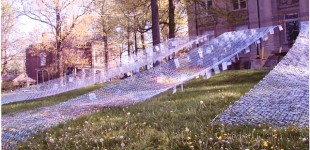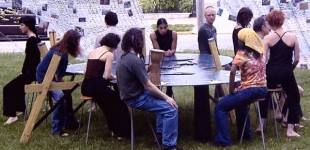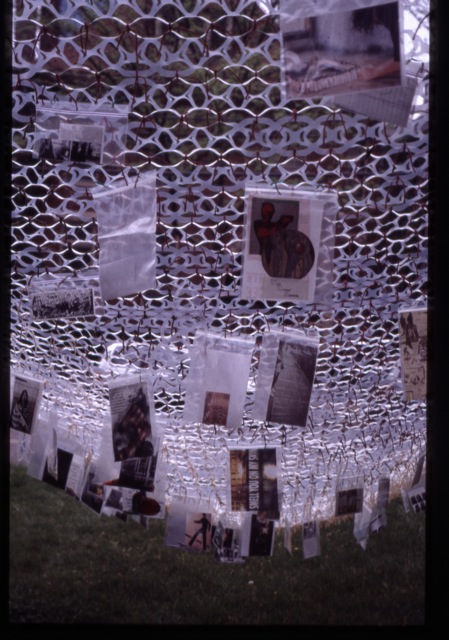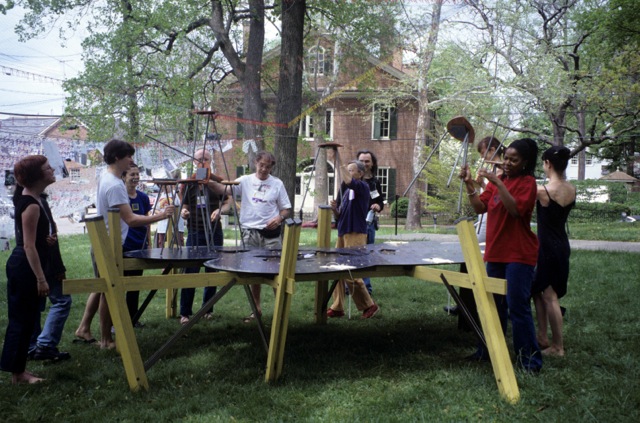FOCAS (Festival of Community Arts South), Lexington KY, 2002
A vast, lightweight outdoor structure spans over the lawn, in front of the Carnegie Center. This structure, part tent part grid/netting consists of three parallel bands, 12’x60’, made of 6000 six-pack ringers. Three to four hundred freezer bags hang from the grid and contain pictures, notes, objects and commentaries around contemporary works of art at the intersection of art and activism.
Under it there is a table ((12’x16’) with a world map seen from the North pole (wood, steel, lead, paint, gold leaf, waterproof paper) and 12 three-legged seats (steel and wood).
Remembering the 2000 election…
And…
Every time she sees a bearded man, she sees a Taliban,
Every time I see a head scarf, I see a burka.
Every time he sees a plastic bag, he sees anthrax.
Yet, will she ask you to shave your beard? No.
Will you ask me to wear a beret? No.
Will he let his food rot in the fridg? No.
And…
Wondering about the destiny of representative democracy…
AS ARTISTS, the world takes the shape of questions, doubts, experimentations.
“THE FUTURE IS ON THE TABLE” is a question in itself: an opener. When visual artists, us, acquire an awareness of the socioeconomic factors influencing the production of the arts as well as the limited place of the arts in our culture; when we design our projects around such questions; when we intimately experiment and try to communicate, in various forms, the dilemma it is to choose to work in an immediate “now” environment and keep the freedom to experiment and take risks, alone or collaboratively; then we may be searching and finding many intersections between art and activism.
Yet, when we start to question the primary criteria of quality or success (as in ‘success’ stories); when we ponder about time, even the long time anything takes to be sensed; when, through our work, we look into the difference between working to prevent as opposed to mend; then we may be walking at the edge of art and activism, not where they intersect but where they parallel.
This particular work “THE FUTURE IS ON THE TABLE” Part Two in Lexington KY, addresses the many ways we see the world from here, despite all the information – from true to false – produced daily as news, symbols, performances or marketed items. America is the biggest military power in the world, the biggest money-oriented culture in the world. How do we picture or perceive the rest of the vast world from this podium? At FOCAS, “The Future is on the Table” tries to acknowledge the works and actions of others as grounds or anchors to understand the various relationships between art and activism. It proposes the visual arts as a facilitator for discussion, a tool for community dialogue. It acts as advertisement for FOCAS and the Carnegie Center Library and act some information and content. It offers a semi-comfortable place for leisurely strolls or serious meetings. This work is open. It offers many entrees and perspectives. Everyone is welcome to add to the conversation, to propose plans for a next step.
“THE FUTURE IS ON THE TABLE” Part Two in Lexington was also designed to start a dialogue between the visual artists and the performing artists who are the majority members of Alternate ROOTS, Regional Organization Of Theater South. In Lexington, we had lunch on top of the world, held small group discussions, took notes, and a spontaneous group improvised a dance around the table and through the netting. Thank you so much.





